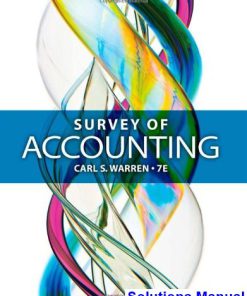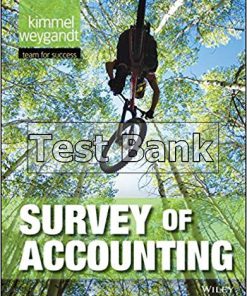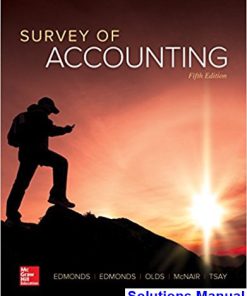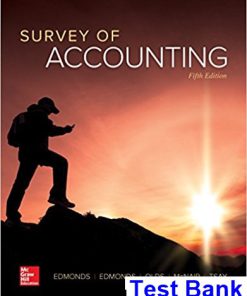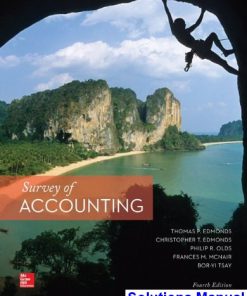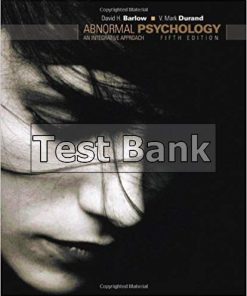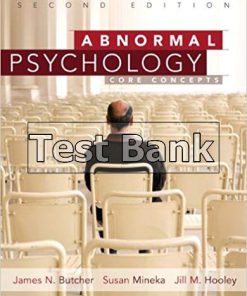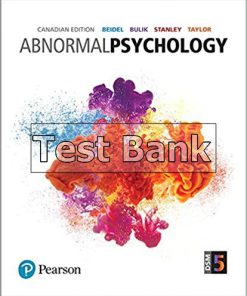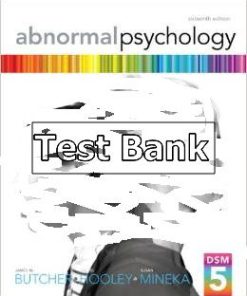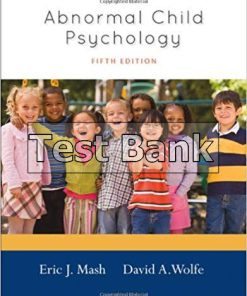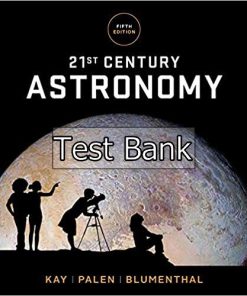-
1 × $26.99
-
Financial Accounting An Introduction to Concepts Methods and Uses 14th Edition Weil Solutions Manual1 × $26.99
-
1 × $26.99
-
1 × $26.99
-
1 × $26.99
Survey of Accounting 4th Edition Edmonds Test Bank
You may also like
Survey of Accounting 4th Edition Edmonds Test Bank

Product details:
- ISBN-10 : 0077862376
- ISBN-13 : 978-0077862374
- Author: Christopher T. Edmonds, Ph.D
Survey of Accounting, 4th edition, is designed to cover both financial and managerial accounting in a single 16-week course, presenting the material in a style easy for non-accounting majors to grasp. It incorporates the same pedagogical innovations that have made Edmonds’ financial and managerial titles such fast-growing successes in the marketplace, including his unique Horizontal Financial Statements Model and a multiple accounting cycle approach that demonstrates the impact of related events over a series of accounting cycles.
Table contents:
- Chapter 1 An Introduction to Accounting
- Section 1: Collecting and Organizing Information
- Role of Accounting in Society
- Using Free Markets to Set Resource Priorities
- Accounting Provides Information
- Types of Accounting Information
- Nonbusiness Resource Usage
- Careers in Accounting
- Measurement Rules
- Reporting Entities
- Elements of Financial Statements
- Using Accounts to Gather Information
- Accounting Equation
- Recording Business Events under the Accounting Equation
- Asset Source Transactions
- Asset Exchange Transactions
- Another Asset Source Transaction
- Asset Use Transactions
- Summary of Transactions
- Interpreting Information Shown in the Accounting Equation
- The Left versus the Right Side of the Accounting Equation
- Two Views of the Right Side of the Accounting Equation
- Cash and Retained Earnings
- Distributions in Business Liquidations
- Recap: Types of Transactions
- Section 2: Reporting Information
- Preparing Financial Statements
- Income Statement and the Matching Concept
- Statement of Changes in Stockholders’ Equity
- Balance Sheet
- Statement of Cash Flows
- The Closing Process
- The Horizontal Financial Statements Model
- Real-World Financial Reports
- Annual Report for Target Corporation
- Special Terms in Real-World Reports
- A Look Back
- A Look Forward
- Self-Study Review Problem
- Key Terms
- Questions
- Multiple-Choice Questions
- Section 1 Exercises
- Section 2 Exercises
- Sections 1 and 2 Problems
- Analyze, Think, Communicate
- Chapter 2 Accounting for Accruals and Deferrals
- Section 1: Accounting for Accruals
- Accrual Accounting
- Accounting for Accounts Receivable
- Other Events
- Accounting for Accrued Salary Expense (Adjusting Entry)
- Summary of Events and General Ledger
- Vertical Statements Model
- The Closing Process
- Steps in an Accounting Cycle
- The Matching Concept
- The Conservatism Principle
- Section 2: Accounting for Deferrals
- Second Accounting Cycle
- Accounting for Supplies Purchase
- Prepaid Items (Cost versus Expense)
- Accounting for Receipt of Unearned Revenue
- Other 2015 Events
- Adjusting Entries
- Accounting for Supplies (Adjusting Entry)
- Accounting for Prepaid Rent (Adjusting Entry)
- Accounting for Unearned Revenue (Adjusting Entry)
- Accounting for Accrued Salary Expense (Adjusting Entry)
- Summary of Events and General Ledger
- Vertical Statements Model
- Transaction Classification
- A Look Back
- A Look Forward
- Self-Study Review Problem
- Key Terms
- Questions
- Multiple-Choice Questions
- Section 1 Exercises
- Section 2 Exercises
- Sections 1 and 2 Problems
- Analyze, Think, Communicate
- Chapter 3 Accounting for Merchandising Businesses
- Product Costs versus Selling and Administrative Costs
- Allocating Inventory Cost between Asset and Expense Accounts
- Perpetual Inventory System
- Effects of 2014 Events on Financial Statements
- Financial Statements for 2014
- Transportation Cost, Purchase Returns and Allowances, and Cash Discounts Related to Inventory Purcha
- Effects of 2015 Events on Financial Statements
- Accounting for Purchase Returns and Allowances
- Purchase Discounts
- The Cost of Financing Inventory
- Accounting for Transportation Costs
- Adjustment for Lost, Damaged, or Stolen Inventory
- Recognizing Gains and Losses
- Multistep Income Statement
- Events Affecting Sales
- Accounting for Sales Returns and Allowances
- Accounting for Sales Discounts
- Common Size Financial Statements
- A Look Back
- A Look Forward
- Appendix
- Self-Study Review Problem
- Key Terms
- Questions
- Multiple-Choice Questions
- Exercises
- Problems
- Analyze, Think, Communicate
- Chapter 4 Internal Controls, Accounting for Cash, and Ethics
- Key Features of Internal Control Systems
- Separation of Duties
- Quality of Employees
- Bonded Employees
- Required Absences
- Procedures Manual
- Authority and Responsibility
- Prenumbered Documents
- Physical Control
- Performance Evaluations
- Limitations
- Accounting for Cash
- Controlling Cash
- Checking Account Documents
- Reconciling the Bank Account
- Determining True Cash Balance
- Illustrating a Bank Reconciliation
- Importance of Ethics
- Common Features of Criminal and Ethical Misconduct
- Role of the Independent Auditor
- The Financial Statement Audit
- Materiality and Financial Audits
- Types of Audit Opinions
- Confidentiality
- A Look Back
- A Look Forward
- Self-Study Review Problem
- Key Terms
- Questions
- Multiple-Choice Questions
- Exercises
- Problems
- Analyze, Think, Communicate
- Chapter 5 Accounting for Receivables and Inventory Cost Flow
- Allowance Method of Accounting for Uncollectible Accounts
- Accounting Events Affecting the 2014 Period
- Accounting Events Affecting the 2015 Period
- Estimating Uncollectible Accounts Expense Using the Percent of Revenue (Sales) Method
- Analysis of Financial Statements
- Estimating Uncollectible Accounts Expense Using the Percent of Receivables Method
- Matching Revenues and Expenses versus Asset Measurement
- Accounting for Notes Receivable (Promissory Notes)
- How Accounting for Notes Receivable Affects Financial Statements
- Financial Statements
- Accounting for Credit Card Sales
- Inventory Cost Flow Methods
- Specific Identification
- First-In, First-Out (FIFO)
- Last-In, First-Out (LIFO)
- Weighted Average
- Physical Flow
- Effect of Cost Flow on Financial Statements
- Effect on Income Statement
- Effect on Balance Sheet
- Multiple Layers with Multiple Quantities
- Allocating Cost of Goods Available for Sale
- Effect of Cost Flow on Financial Statements
- A Look Back
- A Look Forward
- Self-Study Review Problem 1
- Self-Study Review Problem 2
- Key Terms
- Questions
- Multiple-Choice Questions
- Exercises
- Problems
- Analyze, Think, Communicate
- Chapter 6 Accounting for Long-Term Operational Assets
- Tangible versus Intangible Assets
- Tangible Long-Term Assets
- Intangible Assets
- Determining the Cost of Long-Term Assets
- Basket Purchase Allocation
- Methods of Recognizing Depreciation Expense
- Dryden Enterprises Illustration
- Straight-Line Depreciation
- Financial Statements
- Double-Declining-Balance Depreciation
- Units-of-Production Depreciation
- Comparing the Depreciation Methods
- Revision of Estimates
- Revision of Life
- Revision of Salvage
- Continuing Expenditures for Plant Assets
- Costs That Are Expensed
- Costs That Are Capitalized
- Natural Resources
- Intangible Assets
- Trademarks
- Patents
- Copyrights
- Franchises
- Goodwill
- Expense Recognition for Intangible Assets
- Expensing Intangible Assets with Identifiable Useful Lives
- Impairment Losses for Intangible Assets with Indefinite Useful Lives
- Balance Sheet Presentation
- Effect of Judgment and Estimation
- Effect of Industry Characteristics
- A Look Back
- A Look Forward
- Self-Study Review Problem
- Key Terms
- Questions
- Multiple-Choice Questions
- Exercises
- Problems
- Analyze, Think, Communicate
- Chapter 7 Accounting for Liabilities
- Accounting for Current Liabilities
- Accounting for Notes Payable
- Accounting for Sales Tax
- Contingent Liabilities
- Warranty Obligations
- Financial Statements
- Accounting for Long-Term Debt
- Installment Notes Payable
- Line of Credit
- Bond Liabilities
- Bonds Issued at Face Value
- Amortization Using the Straight-Line Method
- Bonds Issued at a Discount
- Bonds Issued at a Premium
- Security for Loan Agreements
- Current versus Noncurrent
- A Look Back
- A Look Forward
- Appendix
- Self-Study Review Problem
- Key Terms
- Questions
- Multiple-Choice Questions
- Exercises
- Problems
- Analyze, Think, Communicate
- Chapter 8 Proprietorships, Partnerships, and Corporations
- Forms of Business Organizations
- Advantages and Disadvantages of Different Forms of Business Organization
- Regulation
- Double Taxation
- Limited Liability
- Continuity
- Transferability of Ownership
- Management Structure
- Ability to Raise Capital
- Appearance of Capital Structure in Financial Statements
- Presentation of Equity in Proprietorships
- Presentation of Equity in Partnerships
- Presentation of Equity in Corporations
- Characteristics of Capital Stock
- Par Value
- Stated Value
- Other Valuation Terminology
- Stock: Authorized, Issued, and Outstanding
- Classes of Stock
- Accounting for Stock Transactions on the Day of Issue
- Issuing Par Value Stock
- Stock Classification
- Stock Issued at Stated Value
- Stock Issued with No Par Value
- Financial Statement Presentation
- Stockholders’ Equity Transactions after the Day of Issue
- Treasury Stock
- Cash Dividend
- Stock Dividend
- Stock Split
- Appropriation of Retained Earnings
- Financial Statement Presentation
- Investing in Capital Stock
- Receiving Dividends
- Increasing the Price of Stock
- Exercising Control through Stock Ownership
- A Look Back
- A Look Forward
- Self-Study Review Problem
- Key Terms
- Questions
- Multiple-Choice Questions
- Exercises
- Problems
- Analyze, Think, Communicate
- Chapter 9 Financial Statement Analysis
- Factors in Communicating Useful Information
- The Users
- The Types of Decisions
- Information Analysis
- Methods of Analysis
- Horizontal Analysis
- Vertical Analysis
- Ratio Analysis
- Objectives of Ratio Analysis
- Measures of Debt-Paying Ability
- Liquidity Ratios
- Solvency Ratios
- Measures of Profitability
- Measures of Managerial Effectiveness
- Stock Market Ratios
- Limitations of Financial Statement Analysis
- Different Industries
- Changing Economic Environment
- Accounting Principles
- A Look Back
- A Look Forward
- Self-Study Review Problem
- Key Terms
- Questions
- Multiple-Choice Questions
- Exercises
- Problems
- Analyze, Think, Communicate
- Chapter 10 An Introduction to Management Accounting
- Differences between Managerial and Financial Accounting
- Users and Types of Information
- Level of Aggregation
- Regulation
- Information Characteristics
- Time Horizon and Reporting Frequency
- Product Costing in Manufacturing Companies
- Components of Product Cost
- Tabor Manufacturing Company
- Average Cost per Unit
- Costs Can Be Assets or Expenses
- Effect of Product Costs on Financial Statements
- Overhead Costs: A Closer Look
- Manufacturing Product Cost Summary
- Schedule of Cost of Goods Manufactured and Sold
- Upstream and Downstream Costs
- Product Costing in Service and Merchandising Companies
- Just-in-Time Inventory
- Just-in-Time Illustration
- Statement of Ethical Professional Practice
- A Look Back
- A Look Forward
- Appendix
- Self-Study Review Problem
- Key Terms
- Questions
- Multiple-Choice Questions
- Exercises
- Problems
- Analyze, Think, Communicate
- Chapter 11 Cost Behavior, Operating Leverage, and Profitability Analysis
- Fixed Cost Behavior
- Operating Leverage
- Calculating Percentage Change
- Risk and Reward Assessment
- Variable Cost Behavior
- Risk and Reward Assessment
- An Income Statement under the Contribution Margin Approach
- Measuring Operating Leverage Using Contribution Margin
- Cost Behavior Summarized
- Mixed Costs (Semivariable Costs)
- The Relevant Range
- Context-Sensitive Definitions of Fixed and Variable
- Determining the Break-Even Point
- Equation Method
- Contribution Margin per Unit Method
- Determining the Sales Volume Necessary to Reach a Desired Profit
- Calculating the Margin of Safety
- A Look Back
- A Look Forward
- Self-Study Review Problem 1
- Self-Study Review Problem 2
- Key Terms
- Questions
- Multiple-Choice Questions
- Exercises
- Problems
- Analyze, Think, Communicate
- Chapter 12 Cost Accumulation, Tracing, and Allocation
- Determine the Cost of Cost Objects
- Estimated versus Actual Cost
- Assignment of Costs to Objects in a Retail Business
- Identifying Direct and Indirect Costs
- Cost Classifications—Independent and Context Sensitive
- Allocating Indirect Costs to Objects
- Determining the Cost to Be Allocated Using Cost Pools
- Selecting the Cost Driver
- Cause and Effect versus Availability of Information
- Behavioral Implications
- Cost Drivers for Variable Overhead Costs
- Cost Drivers for Fixed Overhead Costs
- The Human Factor: A Comprehensive Example
- Using Cost Allocations in a Budgeting Decision
- Using Cost Drivers to Make Allocations
- Choosing the Best Cost Driver
- Controlling Emotions
- A Look Back
- A Look Forward
- Self-Study Review Problem
- Key Terms
- Questions
- Multiple-Choice Questions
- Exercises
- Problems
- Analyze, Think, Communicate
- Chapter 13 Relevant Information for Special Decisions
- Relevant Information
- Sunk Cost
- Opportunity Costs
- Relevance Is an Independent Concept
- Relevance Is Context Sensitive
- Relationship between Relevance and Accuracy
- Quantitative versus Qualitative Characteristics of Decision Making
- Differential Revenue and Avoidable Cost
- Relationship of Cost Avoidance to a Cost Hierarchy
- Relevant Information and Special Decisions
- Special Order Decisions
- Outsourcing Decisions
- Segment Elimination Decisions
- Summary of Relationships between Avoidable Costs and the Hierarchy of Business Activity
- Equipment Replacement Decisions
- A Look Back
- A Look Forward
- Self-Study Review Problem
- Key Terms
- Questions
- Multiple-Choice Questions
- Exercises
- Problems
- Analyze, Think, Communicate
- Chapter 14 Planning for Profit and Cost Control
- The Planning Process
- Three Levels of Planning for Business Activity
- Advantages of Budgeting
- Budgeting and Human Behavior
- The Master Budget
- Hampton Hams Budgeting Illustration
- Sales Budget
- Inventory Purchases Budget
- Selling and Administrative Expense Budget
- Cash Budget
- Pro Forma Financial Statements
- Pro Forma Income Statement
- Pro Forma Balance Sheet
- Pro Forma Statement of Cash Flows
- A Look Back
- A Look Forward
- Self-Study Review Problem
- Key Terms
- Questions
- Multiple-Choice Questions
- Exercises
- Problems
- Analyze, Think, Communicate
- Chapter 15 Performance Evaluation
- Decentralization Concept
- Responsibility Centers
- Controllability Concept
- Preparing Flexible Budgets
- Determining Variances for Performance Evaluation
- Sales and Variable Cost Volume Variances
- Interpreting the Sales and Variable Cost Volume Variances
- Fixed Cost Considerations
- Flexible Budget Variances
- Calculating the Sales Price Variance
- The Human Element Associated with Flexible Budget Variances
- Need for Standards
- Managerial Performance Measurement
- Return on Investment
- Qualitative Considerations
- Factors Affecting Return on Investment
- Residual Income
- Calculating Multiple ROIs and/or RIs for the Same Company
- Responsibility Accounting and the Balanced Scorecard
- A Look Back
- A Look Forward
- Self-Study Review Problem 1
- Self-Study Review Problem 2
- Key Terms
- Questions
- Multiple-Choice Questions
- Exercises
- Problems
- Analyze, Think, Communicate
- Chapter 16 Planning for Capital Investments
- Capital Investment Decisions
- Time Value of Money
- Determining the Minimum Rate of Return
- Converting Future Cash Inflows to Their Equivalent Present Values
- Techniques for Analyzing Capital Investment Proposals
- Net Present Value
- Internal Rate of Return
- Techniques for Measuring Investment Cash Flows
- Cash Inflows
- Cash Outflows
- Techniques for Comparing Alternative Capital Investment Opportunities
- Net Present Value
- Internal Rate of Return
- Relevance and the Time Value of Money
- Tax Considerations
- Techniques that Ignore the Time Value of Money
- Payback Method
- Unadjusted Rate of Return
- Real-World Reporting Practices
- Postaudits
- A Look Back
- Appendix
- Self-Study Review Problem
- Key Terms
- Questions
- Multiple-Choice Questions
- Exercises
- Problems
- Analyze, Think, Communicate
- Appendix A Accessing the EDGAR Database through the Internet
- Appendix B The Double-Entry Accounting System
- Glossary
- Photo Credits
- Index
People also search:
survey of accounting 4th edition
is survey of accounting hard
4-4-5 accounting method
what is a 4-4-5 accounting cycle
a survey of 400 non fatal accidents

































